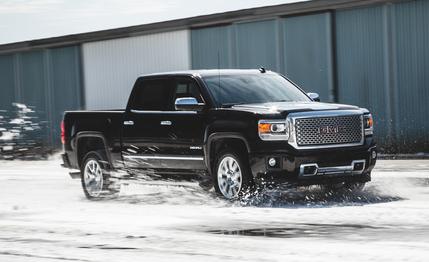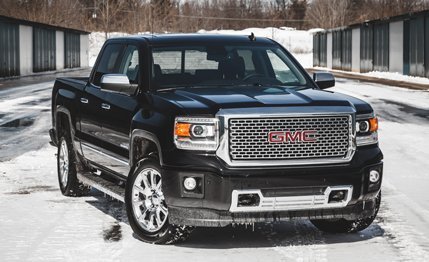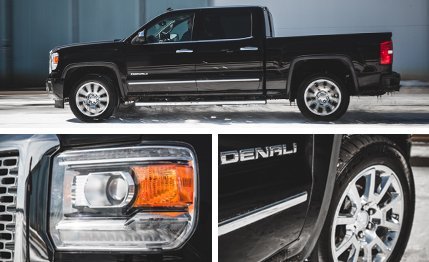 Instrumented Test
Instrumented Test
When the grille on a 2014 Sierra Denali pickup first looms in your rearview mirror, you’re going to wonder one thing: Why is a chrome fireplace enclosure chasing me down the street? Okay, maybe you won’t wonder that. We did, but we must admit to aberrant architectural musings when confronted by square-shouldered rigs like this GMC pickup.
So here’s something more automotive to ponder while you dim the rearview mirror to dowse the glare off the chrome: Did the driver shell out the extra $1995 to get the 6.2-liter V-8 engine upgrade from the standard 5.3? Because if he did, and he’s clever enough to engage four-wheel drive via the knob on the left side of the dashboard to make sure all 420 horsepower gets to the ground, that Denali—the trim that we tested—can be moving one mile per minute in 5.4 seconds, on its way to a 14.1-second quarter-mile at 99 mph. Those numbers would match up nicely with sports sedans like the Cadillac ATS and be more than sufficient to surprise the occasional pony car when the traffic signal turns green.

Not a bad trick for only two grand more, a small bump relative to the ordinary 6.2-liter-optioned Sierra 4x4 SLT crew cab’s $48,100 price. Our wicked black Denali test truck started at $51,060 and had a few other options, including a $495 Driver Alert package (lane-departure warning, forward-collision alert, and a driver’s seat that vibrates to get your attention), a $995 glass sunroof, and a $230 trailer-brake controller, bringing the as-tested price to $54,730, or not quite $10 per pound.
Since our Sierra Denali test truck weighed in at 5672 pounds and has the drag coefficient of, well, a fireplace enclosure, the quarter-mile sprint is pretty much the story on the performance front. It gets to 100 mph in 14.5, and holding the pedal to the carpet for four more seconds takes it to its 110-mph terminal velocity. Thanks to four-wheel drive, at least one of our testers reported “playing rally driver” on dirt roads while avoiding crash-congested highways after a late-winter snow, but neither the steering nor the brakes really invite such adventuring; it’s still about the engine.

The “Corvette Engine”
Truck people refer to this 6.2-liter V-8 as the “Corvette engine,” with no lack of encouragement from GM marketers happy to highlight the similarities. This strikes us as a little backward because, since forever, Corvettes have both benefited and been derided by sports-car purists for having highly tuned pushrod truck engines. Sharing the engineering and manufacturing costs across the mass-produced truck versions is what helps make a Corvette one of the world’s great performance bargains. Call it what you will, this latest 6.2-liter small-block, tuned here to deliver torque earlier and to cost less to build than a real Corvette engine, is gutsy and smooth and mates well with the six-speed automatic. We almost said the engine was quiet, too, but it’s notably louder if you stand outside, out of reach of the standard noise-cancellation technology in the cabin.
Another modern enhancement, cylinder deactivation, turns the V-8 into a V-4 under light loads to conserve fuel. The transitions between modes are smooth and barely noticeable. The driver-information center in the instrument panel has an indicator light—pay attention to the light for a while, and it’ll train your fingers and ears to detect the difference (there’s a slight increase in coarseness in V-4 mode). It might also train your right foot to tread lightly enough to get better fuel economy than the 14 mpg we observed, smack dab on top of the EPA city estimate. By the way, premium-grade fuel is recommended but not required.